NEW YORK, NY October 10, 2006 – Reed Business Information (RBI) and the NBC Universal Television Stations have announced the winners of the second annual Quill Awards, named this evening during a star-studded ceremony at the American Museum of Natural History in New York City, hosted by NBC News’ Lester Holt, with special performances by Fantasia, Lewis Black, and the Tony Award-winning cast of Broadway’s “Avenue Q.” Celebrity presenters included Anderson Cooper, Liz Smith, Donald Trump, Stanley Tucci, Harry Connick, Jr., Dominick Dunne, Sue Monk Kidd, James Patterson, Judy Blume, Janet Evanovich, Mary Matalin, Suzanne Somers, Rhea Perlman, S. Epatha Merkerson, Judd Hirsch, Ann Brashares, Marianne Williamson, Dana Delany, and Daniel Handler (aka Lemony Snicket), among others.
--From the Official Press Release
I could post 20 pages about the 12 hours between 11 a.m. and 11 p.m. Tuesday. But I don't have time to write it and you sure wouldn't want to read it. Here are some bullet points, most drafted while sitting in airports on the way home.
The Overlook Lounge: Years ago, in a pub that sits in the shadow of the Chrysler Building, a group of cartoonists filled a wall with drawings in lieu of paying their tab. The wall has been respected and preserved through changes in ownership, and the tradition revived with contemporary cartoonists today. So one of the first things I did after deplaning from my red-eye flight to JFK early Tuesday was meet my cartoonist friend Mike Lynch at the Overlook to draw on their wall. I took some pictures and will devote a whole post to this humbling honor in the next day or two. If you'd like a sneak preview, Mike's already written about it
on his blog.
The City: With a few visits under my belt, I'm pretty comfortable navigating Manhattan and using the subway. This trip, my expertise grew to encompass the subtle distinction between "local" and "express." Also, the fact that "Rockaway Ave." and "Far Rockaway" are two different places.
I hadn't seen Grand Central Station since my first visit to New York more than 10 years ago, and I kind of stumbled on it by accident this time ("What the heck is this big building in my way--Oh!"). It is simply the sort of magnificent public space that has always distinguished the world's great cities from the wannabes. I wandered and ogled.
 Iconic.
Iconic.
The weather was perfect and it's easy to understand how New York City can sometimes seem like the center of the whole universe.
Harry N. Abrams: No one at my publisher's offices could believe I'd never been there before when I darkened their door Tuesday afternoon. I'd met many Abrams people, but never on their home turf. It was one of the highlights of the day and, by itself, made the trip worthwhile. They expressed so much genuine warmth and appreciation for Mom's Cancer that I was a little overwhelmed (thank you, Sylvia). Somebody welcomed me home and that's kind of how it felt. Very nice.

Above: Editor Charlie Kochman and
me at the Abrams offices, 4 p.m.
Below, same guys at 7 p.m.
We cleaned up all right.
 The Venue:
The Venue: The Quill Awards ceremony was held at the American Museum of Natural History, which, like Grand Central Station, embodies the ambitious architecture and purpose that help define greatness. From the dinosaur fossils in the entry hall to the diorama displays throughout, it is an iconic institution. Following a reception under the dinosaurs, we were directed to the Milstein Hall of Ocean Life, a large room whose focal point is a full-scale model of a blue whale suspended from the ceiling. Whoa. Comics journalist Heidi MacDonald noted that it would have been the perfect place and time for a supervillain to smash through the roof to threaten the pampered, overdressed elite of Gotham City, and she was right.
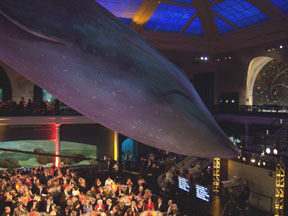
Above, attendees in Milstein Hall
under the whale (with TV cameras
and teleprompters beneath its snout).
Below, Heidi MacDonald and Charlie.
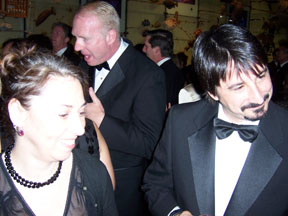
The People: The press release above lists some of the people who were there to present awards. I got a close look at a few of them. I shared an elevator ride with Rhea Perlman, with whom I made eye contact and traded a "How 'bout this?" smile. I saw a lot of Judd Hirsch--during the reception, we just always seemed to end up standing near each other. Anderson Cooper. Harry Connick Jr. Joan Didion. Many familiar faces I couldn't put a name to.
My favorite sighting of the night was crossing paths with Donald Trump, his wife Melania, and the man I know only as "The Old Guy Who Works for Trump on The Apprentice." I was going down an otherwise-empty staircase as they were coming up. Charlie later pointed out what a great service I could've done for humanity with just one small shove. I could'a made it look like an accident, too.
Location, Location, Location: The first omen that it might not be our night came when we were seated in the balcony. We reassured ourselves that was only because Abrams is a small publishing house that had RSVPed late. The view was nice. Had we won, it would've been a short, easy trot down a few steps to the stage. But, in fact, I observed over the evening that none of the winners emerged from the balcony. Thus, should you ever find yourself in a similar situation, I think you can rely on this rule of thumb: If there is a flight of stairs between you and your potential award, you ain't getting one.
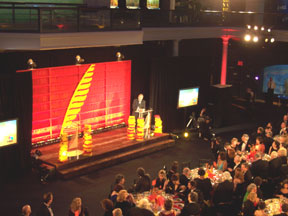 My view of the stage, with
My view of the stage, with
Lewis Black performing.
The Food: Surprisingly great. A salad of greens and cheesy-stuff, a perfectly grilled filet mignon, potatoes, green beans, creme brulee, all the wine you could drink. Organized service. Well done.
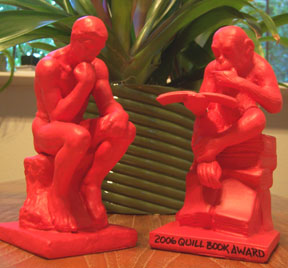 Deprived of a trophy to bring home, I stole part of my
Deprived of a trophy to bring home, I stole part of my
table's centerpiece (left) instead. Charlie liberated the
book-reading chimpanzee from another table for me.
I added the inscription to the base with Sharpie marker.
Below is a photo of my prize as it appeared in situ.
.
Chip Kidd: One of the leading art directors and graphic designers in the world, famous for the book covers he's designed, presenter of the Quill Award for Best Graphic Novel, and a friend of Charlie's. I had opportunities to talk with Chip before and during the Quill Awards and--without betraying confidences that would reveal Chip's true thoughts about the allegedly humorous remarks scripted for him, most of the winners, and almost every aspect of the entire event--I will report that no one I've met uses the word "ghastly" with as much verve as he does. After the awards, Chip invited Charlie and me to his apartment, where we were joined by Charlie's girlfriend Rachel (whom I think the world of) and poet, literary critic, opera librettist, and
Yale Review editor J.D. McClatchy. And the five of us sat on Chip's 17th-story balcony overlooking Manhattan sipping rum and saying spiteful things about other people until we all felt much better about everything.
Sour Grapes: Of the Quill results themselves, almost anything else I could say would sound like sour grapes. Had I won, I would obviously think they were the most perceptive, prestigious, and fairly decided awards around. Therefore, without expressing any opinion at all, I'll just offer three data points from which you may draw your own conclusions:
1. Approximately 200,000 English-language books were published last year.
2. From among that number, the Quill Award nominating committee chose 95 books (in 19 categories) whose authors included Frank McCourt, Doris Kearns Goodwin, E.L. Doctorow, Maya Angelou, Joan Didion, and the Dalai Lama.
3. From among that number, the voting public decided that the winner of the top Quill Award for Book of the Year was this:
.
 Book of the Year. Can it
Book of the Year. Can it
repeat at the Pulitzers?
My Bottom Line: I wanted to win. I'm disappointed I didn't. I think in this case the platitude that "it's an honor just to be nominated" is more true than usual.
As I told Charlie and Chip "Name Drop" Kidd, my hopes for the Quill Award were less about the prize itself than what it could've done to bring new readers to
Mom's Cancer. I don't mean to sound like a big sap, but I really just want people who could maybe get something from it to find it. To that end, I met one or two people who might help us accomplish that anyway.
My trip could've gone better, but all I really missed out on was bringing home a bauble. Compared to everything wonderful that happened, it's not a huge loss.



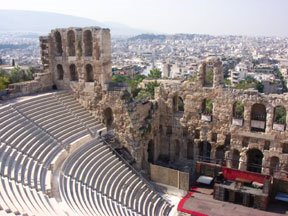


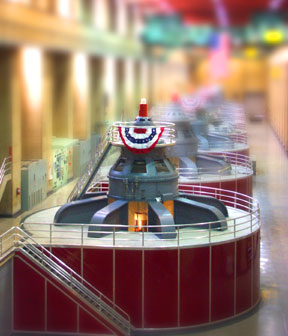




















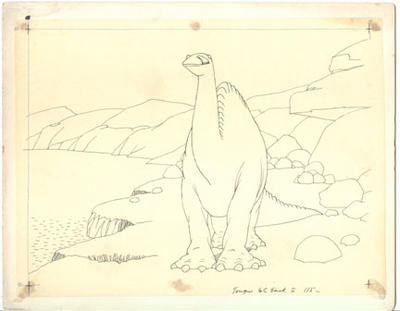
 Iconic.
Iconic.



 My view of the stage, with
My view of the stage, with Deprived of a trophy to bring home, I stole part of my
Deprived of a trophy to bring home, I stole part of my
 Book of the Year. Can it
Book of the Year. Can it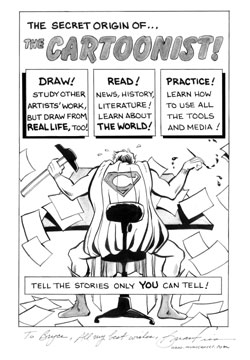 The original is about 8x12 inches, India ink and wash on bristol board, done with all the same brushes, nibs and stuff I used for Mom's Cancer. I wish my lettering were neater; I'm out of practice and working at a different scale here than I did for the book--and since I'm sending Bryce the original, there's no opportunity to fix it in post-production! But overall it captures what I wanted.
The original is about 8x12 inches, India ink and wash on bristol board, done with all the same brushes, nibs and stuff I used for Mom's Cancer. I wish my lettering were neater; I'm out of practice and working at a different scale here than I did for the book--and since I'm sending Bryce the original, there's no opportunity to fix it in post-production! But overall it captures what I wanted.

